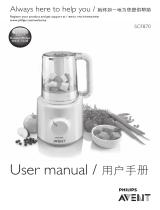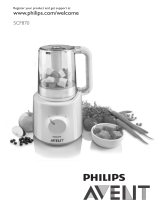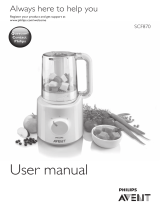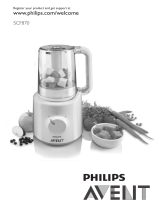
- If the appliance is used improperly, hot steam could come out of the lling opening. Consult the
chapter ‘Troubleshooting’ in order to avoid or to resolve this.
- Never let the appliance operate unattended.
- Never use any accessories or parts from other manufacturers or that Philips does
not specically recommend. If you use such accessories or parts, your guarantee becomes
invalid.
- Do not place the appliance on or near an operating or still hot stove or cooker.
- Always unplug the appliance before you assemble or disassemble any of the parts and before
you clean it.
- Always unplug the appliance and let it cool down before you clean it.
- Never use the jar or any other part of the appliance in a microwave, as the metal parts of the
jar handle and blade unit are not suitable for this use.
- Never sterilise the jar or any other part of the appliance in a steriliser or in a microwave, as the
metal parts of the jar handle and blade unit are not suitable for this use.
- This appliance is intended for household use only. If the appliance is used improperly or for
professional or semi-professional purposes or if it is not used according to the instructions in
the user manual, the guarantee becomes invalid and Philips refuses any liability for damage
caused.
- Place the appliance on a stable, horizontal and level surface. Make sure there is enough free
space around it to prevent damage to e.g. cabinets or other objects, as the appliance emits hot
steam during use.
- Do not use the appliance if it has fallen or is damaged in any way. Take it to an authorised Philips
service centre for repair.
- Never use the steaming function without water.
- Make sure that you do not overll the water tank (max. 200ml). Do not exceed the maximum
level indicated on the measuring cup.
- When you steam ingredients, make sure that you do not overll the jar. Make sure that the top
edge of the green blade unit is not covered with food (Fig. 2).
- When you blend liquids, do not exceed the maximum level indicated on the jar (450ml).
- Do not lift and move the appliance while it is operating.
- Do not insert any object into the lling opening or the steam outlet.
- Never rell the water tank during the steaming process, as hot water and steam may come out
of the appliance as a result.
- Always make sure that the lid has cooled down after steaming before you open it to add more
ingredients for blending, if necessary.
- Never connect this appliance to a timer switch or remote control system in order to avoid a
hazardous situation.
- Always check the temperature of the baby food on the back of your hand before you feed your
baby.
- Always check the consistency of the baby food. Make sure there are no chunks in the food.
- When the steaming process (max. 20 minutes) is nished, do not steam or reheat the baby food
again.
- Only use the spatula supplied to take the food out of the jar.
- Regular descaling prevents damage to the appliance.
The appliance is equipped with a built-in safety lock. The appliance only functions if you have
properly assembled all parts on the motor unit. If all parts are assembled correctly, the built-in safety
lock will be unlocked.
The appliance is also equipped with overheat protection. Overheating could occur if the time
between two steaming processes is too short, if the blending function is used too long or if there
are too much ingredients in the jar. If the overheat protection switches off the appliance during
7

























